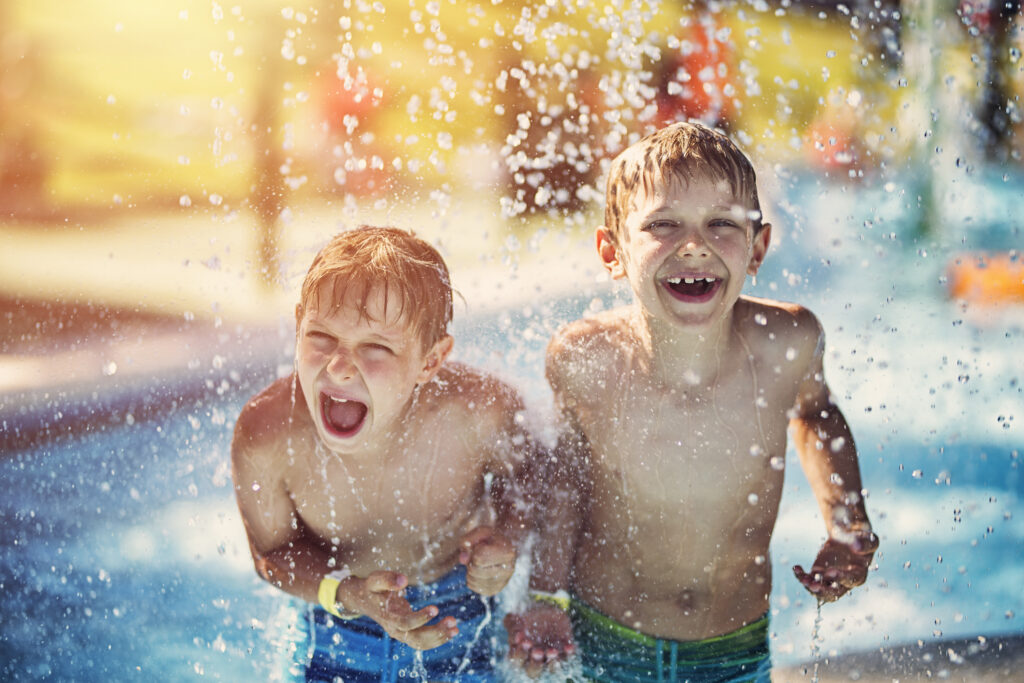Like many businesses across the country, reopening waterparks but will have new rules due to COVID-19. Waterparks need to be aware of the new regulations to comply and assess the new risks involved with an opening during COVID-19. There will be a balance between safety and fun.
The first thing waterparks should do is consult and check the federal, state, and local government health and safety guidelines. Many have different requirements and standards, so it’s important to know what is considered acceptable. The best practice is to follow the most stringent rules.
Most places will likely start with a partial re-opening that focuses on social distancing. Additional queue line space will likely be required, and park capacity will be limited to avoid large groups forming.
The Centers for Disease Control and Prevention has said there is no evidence COVID-19 can spread in water play areas, such as pools or water parks. Proper sanitation practices, such as using chlorine, should inactivate the virus in the water.
Reopening Waterparks: COVID-19 Risk Mitigation
The World Waterpark Association has been working with public health officials and water park operators to develop strategies to protect guests’ health and safety as waterparks reopen.
Communication
Owners and operators must consider the systems they will be using to share information with employees and guests. Communicate information accurately and timely. In the context of communication, operators need to consider:
STAFF
- Changes to the hiring and training process.
- On-boarding staff and orientation procedures.
- Changes to employee protection to mitigate their risk of exposure.
- What policies and procedures need to be in place to protect guests from exposure to COVID-19.
GUESTS
- Operational changes that impact the guests’ use of the facility.
- How guests can act to protect themselves from unnecessary exposure.
- Development of pre-visit and in-park message delivery systems like websites, advertising, social media, and signage to educate guests about expectations.
Owners and operators should provide disinfectant wipes and sanitizer for guests stationed strategically throughout the park. Some waterparks are also providing masks to guests and increased signage displaying enhance cleaning procedures.
Training
Reopening waterparks will require time for staff-specific training to ensure the team is aware of their new responsibilities. Some waterparks employ young, inexperienced staff seasonally. New team members need to go through safe operating procedures and additional COVID-19 measures.
Public health officials expect parks to have plans that detail the training and show all employees have completed it. This includes checklists, procedure manuals, and detailed records of any incidents. Supervisors need to frequently monitor to reinforce training and inform management about any measures not being taken seriously.
The Occupational Safety and Health Administration (OSHA) has developed Guidance on Preparing Workplaces for COVID-19. The document provides guidance employers can use to reduce employee risk of exposure to COVID-19.
Even with the best training and adherence to operational procedures, employees can still contact employees or guests who have contracted COVID-19. All employees should be trained on the protocol and steps to follow when they or a guest shows symptoms of COVID-19.
Capacity
It looks like many public health jurisdictions will require capacities of 50 percent or less on the initial opening. To meet the physical distancing guidelines, waterpark operators need to determine the best method to calculate guest capacity. Many are using reservation-only to accommodate guests, and day passes might only be sold on specific days.
Common methods used are allowing for 36 square feet of space per person. Chairs will be rearranged, and masks won’t be required to wear in water since it will create difficulty breathing. The guidelines are subject to change; operators should be prepared to recalculate park capacity as needed to remain in compliance.
Waterparks should prepare for capacity limits in buildings, structures, and attractions within the park. Water attractions like wave pools, lazy rivers, and activity pools will require reduced capacity and guest guidelines.
Screening
Reopening plans should include screening procedures for both employees and guests. Waterparks can promote COVID-19 self-screening by providing information on the signs and symptoms of the disease before individuals arrive at the park, and while on-site. Any person that is showing COVID-19 symptoms, as described by the CDC, should not be allowed entrance.
Temperature checks have been identified as one of the quickest and accurate screening tools. The CDC does not mandate them, but state or local health officials may require them. If temperature check is used, appropriate social distancing and PPE should be followed.
Preparing for Other Risks
Safety should always be the top concern when reopening waterparks. While COVID-19 is just one risk to consider reopening, there are always other risks to prepare for. Now is a good time to reevaluate safety practices and procedures to keep employees and guests safe. Ensuring you have the right insurance partner to understand the risks and provide resources during unexpected times is essential.
McGowan Allied Specialty Insurance specializes in the amusement and entertainment industry. We want to provide businesses with the right resources and information to be successful while still maintaining fun. Contact us today for more information.
